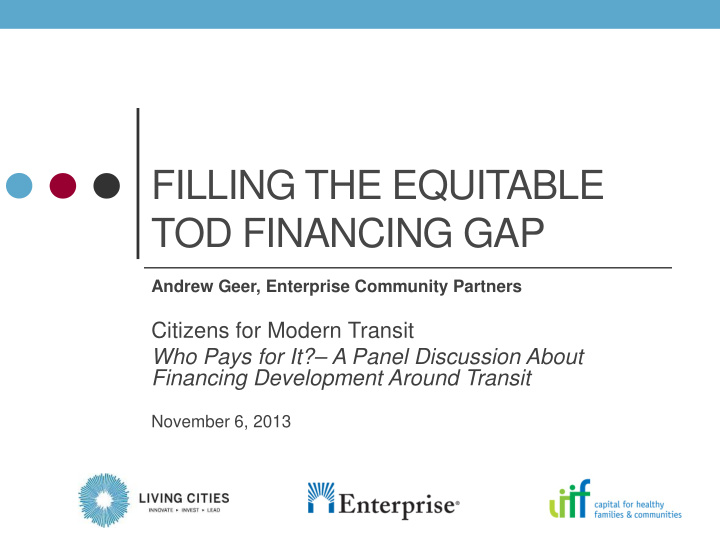



FILLING THE EQUITABLE TOD FINANCING GAP Andrew Geer, Enterprise Community Partners Citizens for Modern Transit Who Pays for It?– A Panel Discussion About Financing Development Around Transit November 6, 2013
THE ENTERPRISE MODEL Connecting Capital Harness investment capital to build healthy, sustainable communities. Capacity Services Financing Innovating Transforming Policy Solutions Engage government to Put ideas into action create and enhance policies to create stronger, that strengthen community thriving communities. development investment. 2
3 What is equitable TOD? Equitable TOD: • Creates equal opportunities for people of all incomes, particularly low-income communities, by prioritizing affordable housing near transit; • Provides transit-accessible services, such as schools, health clinics, childcare and grocery stores; and • Enhances access for transit-dependent populations through connecting bicycle and pedestrian facilities.
4 National White Paper • Enterprise Community Partners (ECP) and the Low Income Investment Fund (LIIF), through their national TOD partnership, were asked by Living Cities to author a paper on TOD finance using capital absorption framework as a lens • Objective: To review the equitable TOD finance system, identify gaps, and suggest innovative financial tools and potential federal, state and local policy solutions • National focus and relevance with regional case studies: Atlanta, Denver, Minnesota-St. Paul, San Francisco Bay Area
5 A Model Equitable TOD Financing System Involves Coordination Among these Key Actors • State/Local/Regional • Business Community government • Community and Community • Metropolitan Planning Based Organizations Organizations (MPOs) • Developers • Transit agencies • Financial Institutions • Philanthropy • National TA providers
6 Implementation of an Equitable TOD System Must Include These Key Components • Acquisition, predevelopment and remediation financing • Infrastructure financing • Debt/equity access during construction and permanent financing phases • Philanthropic and public resources
7 TOD financing systems need to be viewed holistically • Greater need to look at the whole financing system, from predevelopment through permanent financing • Focus too much on one stage of the development process • Housing and business finance exist in silos • Without a clear path to permanent financing, acquisition and development stall • TOD Funds are not a panacea
8 Project Level Challenges • Scale, complexity and land assembly • Mixing uses is difficult in practice • Risk appetite does not meet developers needs • Infrastructure and remediation sources are hard to find • Reliance on unique gap funding difficult to replicate • Sources of permanent financing are limited & competitive
9 Ways to improve equitable TOD financing at project and systems level • Busting the housing and transportation financing silos • Evolve local tools that work for multiple regions or national pools • Test equity as an alternative to debt • Evolve from grants to forgivable loans for remediation and infrastructure • Expand tax increment financing to support all phases of equitable development
10 Recommendations • Create a robust technical assistance and knowledge sharing platform. • Advocate for greater federal, state, and local policies to encourage equitable TOD. • Build on what we have learned – more equitable TOD demonstration programs across the country.
Southland Community Development Fund SSMMA Top loss Oversight Participation in lending decisions CCLF and Consortium Enterprise and Southland Fund Capital aggregator to go beyond $15 million “on balance sheet” resource SCDF Fund Southland Fund for TOD and COD Manager Relationship with land bank, Brownfield Aggregated capital including top loss, Enterprise fund, equity providers, and other lenders PRI second loss and CDFI/bank debt Coordination of funding opportunities and CCLF Underwriting, oversight and lending for consortium members decisions for Fund only Loans and aggregated capital Community Transformation
Southland Fund Parameters Eligible Borrowers Established nonprofit and for-profit developers. Project Types Multifamily residential and/or mixed-use residential housing. Transit Oriented Development Projects must be located: Located within SSMMA member municipality Located within ½ mile of quality transit services (i.e. METRA) and major fixed-route bus transit. Public and Private Support Projects must be able to demonstrate: Local public support from municipality Significant public or private financing Sustainable Communities Grant All projects must support the goals of the SSMMA HUD Sustainable Communities Challenge grant and are subject to HUD requirements.
Proposed Predevelopment Loan Terms Eligible Uses of Loan Proceeds Third party costs (e.g. architectural, engineering, market studies, zoning, and legal) Maximum Loan Size $500,000, non-revolving Interest Rate Loans closed in 2013 are projected at 3.00% Loan Term Up to 3 years Loan Fees 2% origination fee Recourse Full recourse to borrower, including guarantees from parent corporations. Unsecured loans are an option.
Proposed Acquisition Loan Eligible Uses of Loan Proceeds Acquisition of vacant land or currently operating properties. Maximum Loan Size $3,000,000, non-revolving including up to $500,000 for predevelopment or rehab Interest Rate Variable and fixed rate options. Loan Term Up to 5 years Loan Fees 2% origination fee 1 st priority lien on any real estate or Collateral other acceptable collateral Loan to Value 75% - 85% of collateral, appraisal required Equity Requirement 15% - 25%, at least 10% cash equity Recourse Full recourse to borrower, including guarantees from parent corporations
Opportunities and Challenges • Increased developer interest in South Suburban Cook. Rental market is projected to grow modestly in south suburbs. • HUD restrictions have required restructuring of the TOD Fund and the capital stack. Impact on long-term growth of Southland Fund. Availability of additional top-loss. • Lack of development ready sites. • Continue education of what is quality TOD and positive impact on communities. • Strengthening options for take-out financing. Continued advocacy around TOD benefits and coordination with Cook County and South Suburban Land Bank Authorities. • Opportunity for regional collaboration.
16 Andrew Geer Vice President and Market Leader, Chicago Enterprise Community Partners ageer@enterprisecommunity.org 312.803.0790
Recommend
More recommend